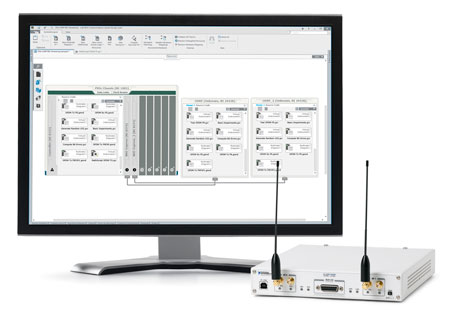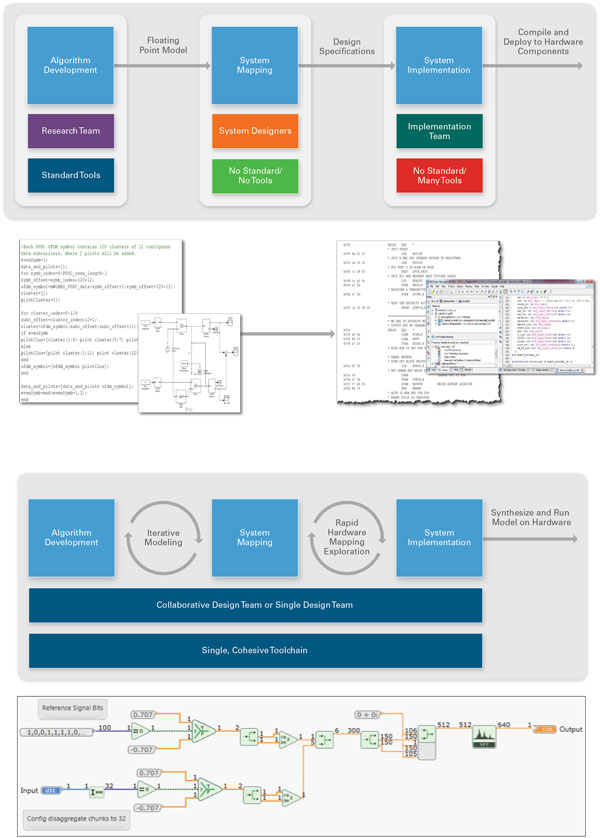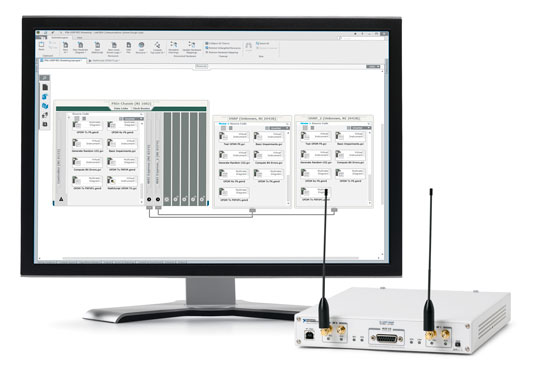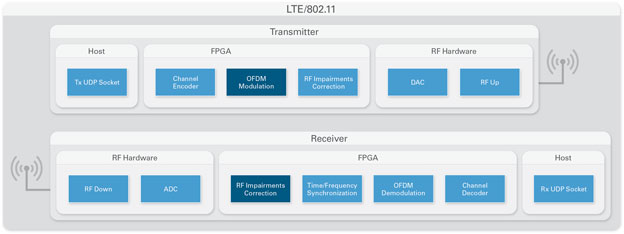
ปัจจุบันนี้ ผู้พัฒนาระบบต้องการกระบวนการสรรค์สร้าง ที่จะดึงความสามารถในการผลิตผลงานต้นแบบของ SDRs ให้ได้มากที่สุด LabVIEW communications เป็นทางออกที่ช่วยให้นักพัฒนาสามารถสร้างสรรค์ผลงานได้อย่างรวดเร็วยิ่งขึ้น
ปัจจุบันมีความต้องการทางเทคโนโลยีสำหรับช่วยเหลือนักพัฒนาระบบ โดยเฉพาะอย่างยิ่งเมื่อมีการเชื่อมต่ออุปกรณ์หลายๆ อย่างเข้าด้วยกันในระบบเครือข่าย ซึ่งในขณะที่ผู้พัฒนาในส่วนของการประมวลผลสัญญาณและนักพัฒนาโครงข่ายไร้สาย พยายามที่จะเอาชนะความท้าทายในเรื่องของช่องสัญญาณ, ความปลอดภัย, ประสิทธิภาพในการใช้พลังงานและการผสมผสานกันนั้น ได้มีสัญญาณบ่งบอกว่า วิธีพัฒนาต้นแบบเพื่อใช้ร่วมกับสัญญาณนั้นยังไม่มีประสิทธิภาพเพียงพอ
There is unprecedented demand for technology that will help today’s system designers scale as society connects and shares more devices and data across networks. While signal processing and communications designers work to define algorithms that overcome pressing challenges regarding bandwidth, security, power efficiency, and coexistence, there’s an alarming lack of designers effectively prototyping solutions with real-world signals.
ในขณะที่อุตสาหกรรม การศึกษา หรือหน่วยงานวิจัยของรัฐบาล ได้มีการเปลี่ยนมาใช้อุปกรณ์ที่เรียนว่าอุปกรณ์รับ-ส่งสัญญาณไร้สาย ที่สามารถปรับเปลี่ยนได้ด้วยซอฟต์แวร์ (SDR) ในการพัฒนารูปแบบใหม่ๆ เพื่อใช้งานร่วมกับสัญญาณและข้อจำกัดในโลกของความเป็นจริงนั้น วิธีที่ใช้ในการพัฒนาก็ยังห่างไกลจากคำว่ามีประสิทธิภาพ น่าเสียดายที่ซอฟต์แวร์ในปัจจุบันนั้น เปรียบเสมือนปากขวดในแง่ของการพัฒนานวัตกรรม เนื่องจากความไม่เป็นระเบียบของรูปแบบการพัฒนา โดยส่วนใหญ่แล้วปัญหานั้นเกิดจากความไม่ต่อเนื่องกัน ระหว่างซอฟต์แวร์ที่ใช้พัฒนาขั้นตอนทางคณิตศาสตร์และซอฟต์แวร์สำหรับพัฒนาอุปกรณ์ ซึ่งในส่วนนี้เองที่ซอฟต์แวร์ LabVIEW เข้ามามีบทบาทเนื่องจากความต่อเนื่องของการพัฒนานั้นมีสูง
While those in industry, academia, and government laboratories have turned to software defined radio (SDR) to evaluate new designs with real-world signals and conditions, the prototyping process is far from efficient. Unfortunately, existing software tools are often a bottleneck to innovation; they offer a disjointed, indirect design flow. In large part, the challenge emerges from the discontinuity between tools well suited for algorithm design and those required to program the hardware components of an SDR. It is precisely this discontinuity that the LabVIEW Communications System Design Suite bridges, providing a unified design flow from algorithm to hardware.
ปัจจุบันนักพัฒนาต่างเลือกใช้งาน SDRs เนื่องจากความยืดหยุ่นในการใช้งาน ซึ่งช่วยเพิ่มความสะดวกในการสร้างสรรค์ผลงานต้นแบบ ความยืดหยุ่นนี้กล่าวถึงตั้งแต่หน่วยประมวลผลทั่วๆ ไป, SDRs แบบทันสมัยที่มีส่วนเชื่อมต่อสัญญาณไร้สาย และ FPGA ที่ผู้ใช้งานสามารถโปรแกรมได้ แต่อย่างไรก็ตามอุปสรรคสำคัญอยู่ที่ซอฟต์แวร์ที่ใช้สำหรับการพัฒนาหน่วยประมวลที่อยู่บนSDRs การสร้างอัลกอริธึมและนำไปใช้กับหน่วยประมวลผลและ FPGA นั้น จำเป็นที่จะต้องใช้อุปกรณ์เฉพาะที่เหมาะสม เพราะเหตุนี้จึงทำให้ทีมนักพัฒนานั้นมีขนาดใหญ่กว่าที่ต้องการ มีระยะเวลาในการพัฒนาที่ยาวนาน และค่าใช้จ่ายที่มากขึ้น ทำให้ผลลัพธ์ที่ออกมานั้น แทนที่จะช่วยส่งเสริมการสร้างสรรค์ผลงาน กลับเป็นการทำให้เกิดอุปสรรคมากยิ่งขึ้น
Designers today choose SDRs because the flexibility they offer holds promise for rapid prototyping. This flexibility stems primarily from computing elements that dictate the behavior of the generic, wide bandwidth RF front end on modern SDRs: multicore processors and large, user-programmable FPGAs. Unfortunately, today’s tools for programming the processor and FPGA found on SDRs eradicate any hope for truly rapid prototyping. Transitioning from algorithm to implementation on a processor and an FPGA demand different specializations and tools. Design teams on the bleeding edge of various technology vectors are forcibly larger than ideal, and engage in design cycles that are long and costly. The result isn’t a smooth, iterative prototyping process that contributes to innovation; rather, the process hinders efficiency and thwarts innovation.

รูปที่ 1 รูปแบบการพัฒนาแบบดั้งเดิม ที่จำเป็นต้องใช้อุปกรณ์ที่หลากหลาย และการแก้ไขอัลกอริททึ่ม เพื่อใช้ในการสร้างผลงานต้นแบบ ซึ่งเป็นอุปสรรคต่อการสร้างสรรค์ผล
Figure 1: The traditional design process necessitates numerous tools and re-writes of an algorithm to realize a hardware prototype. This inefficient flow hinders innovation.
LabVIEW Communications เป็นซอฟต์แวร์ที่เหมาะสำหรับการสร้างสรรค์งานต้นแบบ ด้วยรูปแบบของซอฟต์แวร์เดี่ยวที่มีความครอบคลุมสามารถใช้พัฒนาได้ทั้งระบบประมวลผล และ FPGA นอกจากนี้ยังมี SystemDesigner ซึ่งช่วยให้นักพัฒนาสามารถตรวจสอบการตั้งค่า เข้าถึงเอกสาร อธิบายสถาปัตยกรรม ปรับแต่งองค์ประกอบของระบบ และนำอัลกอริธึมไปใช้งานในอุปกรณ์ นอกจากนี้ยังมีความสามารถในการเข้าถึงช่องสัญญาณและทรัพยากรต่างๆ ของอุปกรณ์ ทำให้ลดปัญหาในการพัฒนาตัวกลางหรือไดร์เวอร์ลงไป
LabVIEW Communications offers a unified design flow for communications system prototyping. It is a single, cohesive design environment that can target both the processor and FPGA. This hardware-aware design environment includes SystemDesigner, which allows designers to validate system setup, access system documentation, describe the system architecture, configure system components, and partition and deploy algorithms to hardware. This unparalleled hardware-software integration also provides access to I/O and resources, eliminating the need for middleware and driver development.

รูปที่2 : LabVIEW communications เป็นซอฟต์แวร์ที่ช่วยในการพัฒนาระบบ ที่มีคุณสมบัติในการตรวจสอบการตั้งค่า และนำอัลกอริธึมต่างๆ ไปใช้งานร่วมกับอุปกรณ์
Figure 2: LabVIEW Communications offers a hardware-aware design environment complete with tools that validate system setup and deploy algorithms to hardware.
นอกจากนี้แล้วเทคโนโลยีคอมไพเลอร์ที่มีอยู่ใน LabVIEW Communications ยังช่วยเพิ่มความยืดหยุ่น และลดความซับซ้อนในการแปลงอัลกอริธึมให้ตรงกับอุปกรณ์ SDR ยกตัวอย่างเช่น ในการพัฒนาอัลกอริธึมที่ใช้ประมวลผลสัญญาณ ฟังก์ชั่น multirate diagram(MRD) ที่มีอยู่ใน LabVIEW Communications นั้น ช่วยให้นักพัฒนาสามารถเชื่อมต่อความเร็วในการทำงานที่ไม่เท่ากันของกระบวนการแต่ละอย่าง โดยที่ไม่ต้องใช้เทคนิค handshaking, buffering และ queuing ระหว่างกระบวนการ หลังจากที่นักพัฒนาออกแบบลูกโซ่สัญญาณใน multirate diagram เป็นที่เรียบร้อยแล้ว พวกเขาสามารถพึ่งความสามารถใช้งานอุปกรณ์ที่สร้างขึ้นมาร่วมกับฟังก์ชั่นดังกล่าว ในการเปลี่ยนแปลงและทดสอบดีไซน์ที่ออกแบบมานั้น กับความต้องการต่างๆ โดยที่หากระบุอัตราเร็วสัญญาณนาฬิกา (Clock rate) เราสามารถใช้คอมไพเลอร์ดังกล่าวในการวิเคราะห์เวลาในการทำงาน รวมถึงทรัพยากรที่ใช้ในฮาร์ดแวร์ SDR ที่ต้องการนำไปใช้ได้อีกด้วย
Furthermore, the advanced compiler technology found in LabVIEW Communications enables considerable flexibility and eases algorithm description to dictate how these algorithms map and perform on SDR hardware. As an example for developing signal processing algorithms, the new multirate diagram (MRD) included in LabVIEW Communications makes it possible for designers to connect processes that run at different rates without the encumbrance of handshaking, buffering, and queuing data between processes. Once researchers design signal chain in a multirate diagram, they can rely on a built-in, interactive, data-driven tool for converting the design to fixed point, and can then explore how the design would perform given different requirements. Simply defining a clock rate and a throughput for the algorithm allows the underlying compiler to analyze the implementation and provide designers with timing and resource estimates specific to the SDR hardware they wish to deploy to.
จากที่กล่าวมา นักพัฒนาจึงไม่ต้องลำบากในการยืนยันผลงาน กับสถาปัตยกรรมของอุปกรณ์ที่จะนำไปใช้งานด้วยตัวเอง เนื่องจากไม่ต้องคอยวิเคราะห์เพื่อหาข้อดีข้อเสียของแต่ละชิ้นงานด้วยตัวเอง งานที่มีความซับซ้อน เช่น ตรวจสอบผลกระทบทำงานที่ไม่ต่อเนื่อง แบ่งพาร์ทิชั่นของหน่วยความจำ การแก้ไขรูปแบบการเข้าถึงหน่วยความจำ เลือกทรัพยากรหรือองค์ประกอบของ FPGA สิ่งเหล่านี้สามารถให้คอมไพเลอร์ที่อยู่ใน LabVIEW Communications ทำแทนได้ ซึ่งทำให้นักพัฒนาสามารถใช้ข้อมูลดังกล่าวในการพัฒนาชิ้นงาน เพื่อให้ตรงกับความต้องการได้ นอกจากนี้นักพัฒนายังสามารถนำอัลกอริธึมดังกล่าว มาใช้งานได้อีกในอนาคต เนื่องจากการพัฒนานั้นถูกทำด้วยภาษาขั้นสูง ซึ่งถูกแปลงมาจากความต้องการโดยตรง
Designers are liberated from having to contend with the underlying hardware architecture they want to deploy to. They no longer need to manually dissect a design to understand the tradeoffs between different implementations. The compiler in LabVIEW Communications does the often complex job of exploring the impact of unrolling loops, partitioning memory, modifying memory access schemes, and selecting different FPGA resources/components. The designer can move forward with an implementation that best suits the design requirements based on the feedback from the compiler. As an added benefit, researchers can achieve considerable reuse as the core algorithms are defined in higher level languages, and the implementation is derived from the design requirements that are imposed upon the algorithm.
ผู้ใช้งานยังสามารถใช้งานโครงสร้างของโปรแกรมที่มากับตัวซอฟต์แวร์ เพื่อที่จะสามารถนำไปใช้ต่อไปได้ในอนาคต ซึ่งโครงสร้างนี้มีซอร์สโค้ดที่มีคำอธิบายและสามารถแก้ไขได้สำหรับ LTE และ 802.11 PHYs ซึ่งเป็นมาตรฐานมาให้ด้วย ดังนั้นนักพัฒนาจึงสามารถใช้เวลาไปกับการพัฒนาส่วนประกอบที่สำคัญอื่นๆ แทน Lastly, users can rely on new Application Frameworks available with LabVIEW Communications to further expedite their design cycle. Application Frameworks provide documented, modifiable, standards-based source code for LTE and 802.11 PHYs. Designers can focus their efforts on the specific components that they are looking to improve over existing LTE and 802.11 designs instead of spending time building the requisite infrastructure needed to properly test the novel algorithms.

รูปที่ 3: เฟรมเวิร์คที่มีอยู่ใน LabVIEW communications ซึ่งมีซอร์ซโค้ด LTE และ 802.11 สำหรับการพัฒนาชิ้นงาน
Figure 3: Application Frameworks included with LabVIEW Communications provide standards-based source code implementations for LTE and 802.11 to further accelerate designs.
ปัจจุบันนี้ ผู้พัฒนาระบบต้องการกระบวนการสรรค์สร้าง ที่จะดึงความสามารถในการผลิตผลงานต้นแบบของ SDRs ให้ได้มากที่สุด LabVIEW communications เป็นทางออกที่ช่วยให้นักพัฒนาสามารถสร้างสรรค์ผลงานได้อย่างรวดเร็วยิ่งขึ้น ด้วยภาษาสำหรับเขียนโปรแกรมที่มีประสิทธิภาพ ทั้งด้านการอธิบายและการออกแบบ นอกจากนี้ซอฟต์แวร์ดังกล่าวยังเป็นซอฟต์แวร์ที่เข้าถึงตัวอุปกรณ์ SDR ได้ ซึ่งมีส่วนช่วยเพิ่มความแม่นยำในการใช้งานร่วมกับช่องสัญญาณอีกด้วย จากสิ่งที่กล่าวไปนี้มีส่วนช่วยให้นักพัฒนาสามารถเอาชนะคู่แข่ง ในการกำหนดมาตรฐานและเป็นผู้ริเริ่มในด้านเทคโนโลยีการสื่อสารไร้สายในอนาคต
Today’s system designers require a design flow that realizes the true potential of SDRs for rapid prototyping. LabVIEW Communications provides a seamless path from algorithm to prototype, helping designers innovate faster. Researchers have access to intuitive, high-level languages enabling efficient algorithm design and system abstraction. The hardware-aware nature of the software with SDR hardware allows for accurate, real-world I/O integration. LabVIEW Communications will help designers outpace competitors in the race to define standards that serve as the foundation for 5G and other future communications systems. With LabVIEW Communications, designers will be able to more quickly realize the solutions that usher in the Internet of Things era.
สงวนลิขสิทธิ์ ตามพระราชบัญญัติลิขสิทธิ์ พ.ศ. 2539 www.thailandindustry.com
Copyright (C) 2009 www.thailandindustry.com All rights reserved.
ขอสงวนสิทธิ์ ข้อมูล เนื้อหา บทความ และรูปภาพ (ในส่วนที่ทำขึ้นเอง) ทั้งหมดที่ปรากฎอยู่ในเว็บไซต์ www.thailandindustry.com ห้ามมิให้บุคคลใด คัดลอก หรือ ทำสำเนา หรือ ดัดแปลง ข้อความหรือบทความใดๆ ของเว็บไซต์ หากผู้ใดละเมิด ไม่ว่าการลอกเลียน หรือนำส่วนหนึ่งส่วนใดของบทความนี้ไปใช้ ดัดแปลง โดยไม่ได้รับอนุญาตเป็นลายลักษณ์อักษร จะถูกดำเนินคดี ตามที่กฏหมายบัญญัติไว้สูงสุด